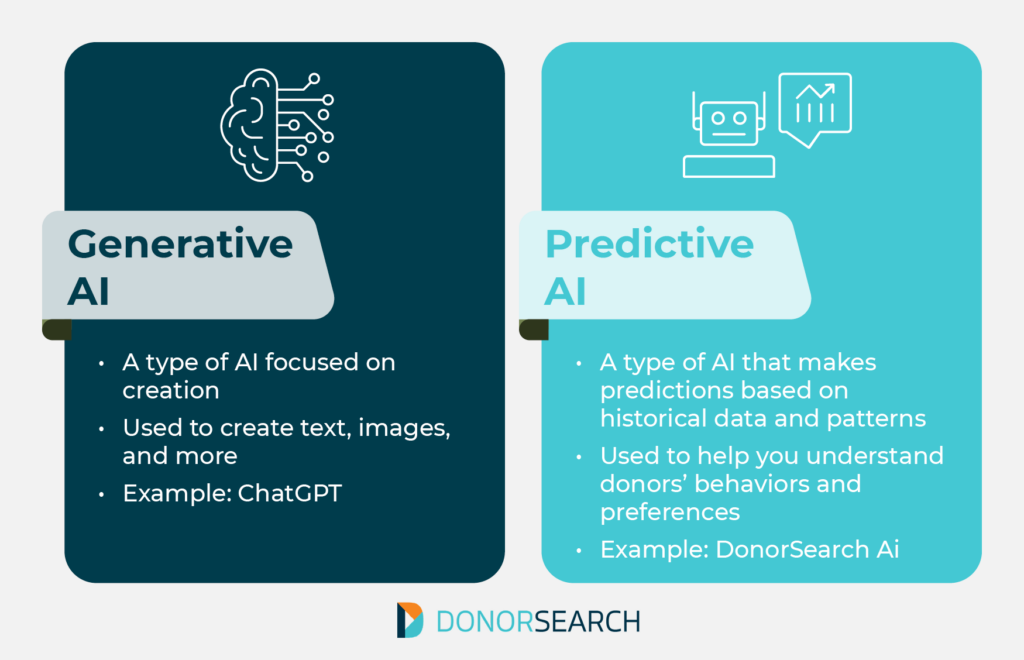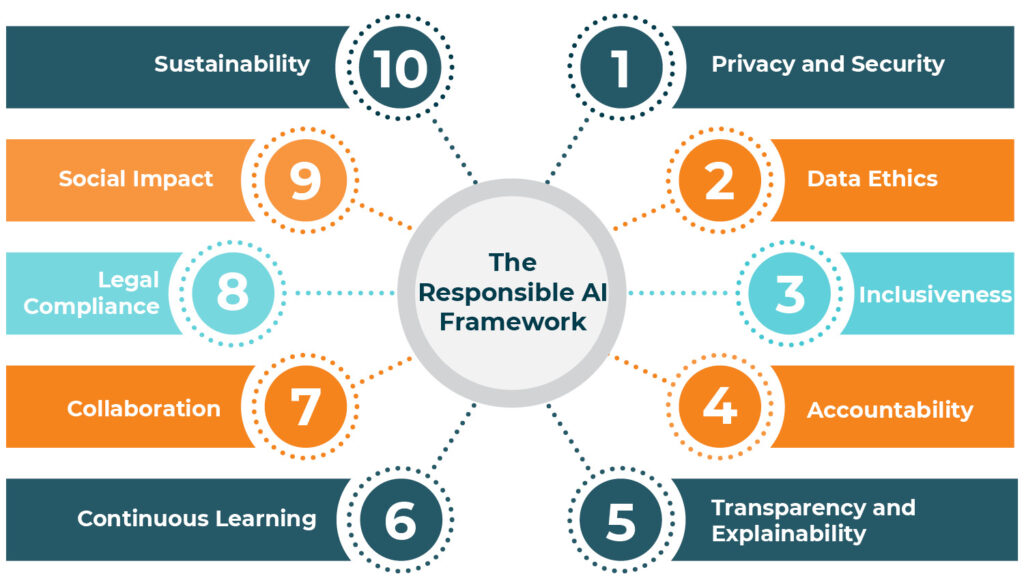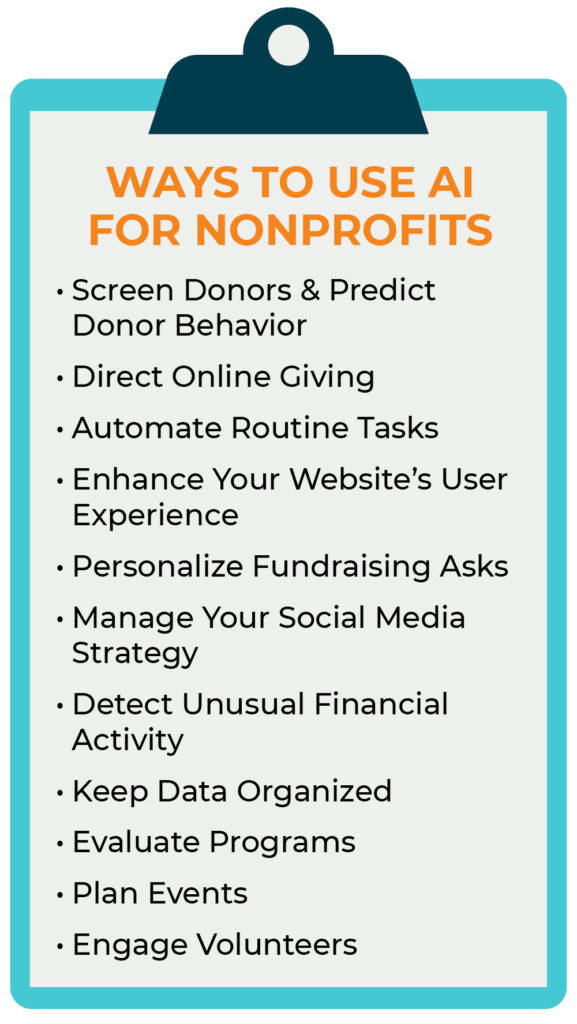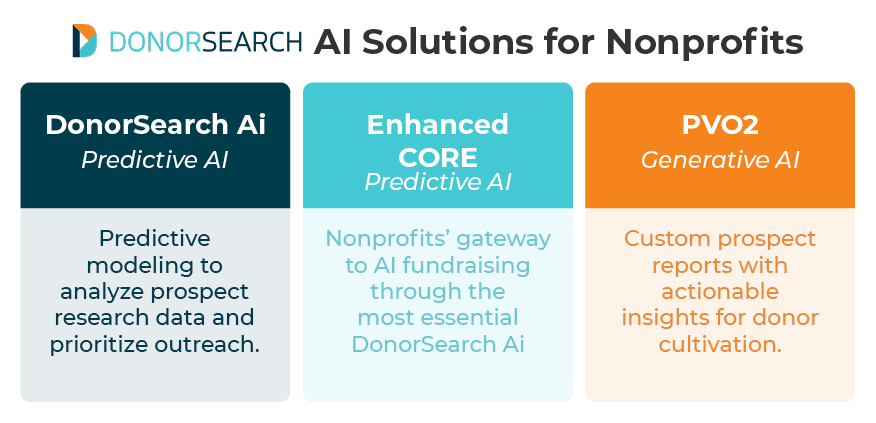
AI for Nonprofits: Everything Your Org Needs to Know
Artificial intelligence (AI) has recently become a hot topic, as it is now prevalent in many aspects of personal and professional life. It’s especially popular in the nonprofit sector—as of 2024, 58% of nonprofits have incorporated AI into their communications, and 68% use it for data analysis, both of which exceed for-profit implementation rates.
If your organization is still on the fence about AI, or you’ve been using it for a while and want to brush up on the basics, you’ve come to the right place! In this guide, we’ll cover everything you need to know about AI for nonprofits, including:
- AI for Nonprofits: FAQ
- Top Ways to Use AI in Nonprofit Work
- A Closer Look at DonorSearch’s Nonprofit AI Tools
When you effectively use the right AI tools to optimize your nonprofit’s operations, you’ll have more time to get back to the nonprofit work that will always require a human touch—building supporter relationships and furthering your mission in the community. Let’s dive in!

AI for Nonprofits: Frequently Asked Questions
To help your nonprofit understand AI, let’s answer some frequently asked questions about its fundamentals.
What is artificial intelligence?
Artificial intelligence is the ability of a machine (like a computer) to “think” like a human and perform tasks like recognizing patterns, processing information, drawing conclusions, and making recommendations.
Despite the recent mainstream interest in AI, AI has actually been a part of our everyday lives for a long time. Here are some examples:
- Social media algorithms personalizing the posts you see in your feed.
- Digital voice assistants like Siri or Alexa answering your questions or helping you perform tasks like adding items to a grocery list.
- Streaming platforms and online retailers giving you recommendations for what to watch or buy next based on your past behavior on their platforms.
- 24/7 customer service chatbots on businesses’ websites helping to answer questions or guide you to the information you’re looking for.
Although you might have heard people say that AI is the future, it’s increasingly becoming the present—whether you’re talking about everyday life or nonprofit fundraising!
What is machine learning?
In discussions of nonprofit AI, the term “machine learning” may come up. Machine learning is simply the process of how an AI tool develops its intelligence. Similar to how a human learns, as the tool is exposed to more data and produces more outputs over time, it gets “smarter” and better at its job.
For example, the more you use a social media platform like Instagram, the better the tool’s AI capabilities will be able to predict what types of content you want to see in your feed. Likewise, the more you use a nonprofit predictive modeling tool to analyze donor data, the better it’ll be at recognizing patterns and making suggestions to inform your engagement strategies.
How does AI work?
There are two key ingredients that all AI tools need to do their jobs:
- A large amount of data: The beauty of AI is that it can handle looking at, analyzing, and making predictions from copious amounts of information!
- A carefully created algorithm: These are mathematical models that the AI tool will use to analyze the data—algorithms give the AI tool its “instructions” for completing the task at hand.
Additionally, there are two categories of AI that you should be familiar with:

- Generative AI uses its machine learning capabilities to produce original content like text, images, audio, and videos.
- Predictive AI analyzes and models data to identify trends, project outcomes, and make actionable recommendations.
The best nonprofit AI strategies leverage generative and predictive AI together—i.e., the insights you gain from predictive analysis can and should inform your content creation.
What are some popular AI tools for nonprofits?
There are many AI tools you could incorporate into your nonprofit’s fundraising intelligence strategy, such as:
- ChatGPT, Gemini, and Microsoft Copilot: These generative AI models can help you make many communication tasks more efficient, from creating email drafts to brainstorming how to explain complex concepts to certain audiences.
- Grammarly: Grammarly helps you improve your writing as you go, whether you’re typing an email or working on a Google doc.
- Canva: Canva is a user-friendly graphic design platform that now offers a free online AI image generator.
- Synthesia: Synthesia allows you to easily create professional videos for your organization that feature AI avatar narrators.
- FeedHive: FeedHive allows you to easily create, schedule, publish, and optimize social media content for maximum engagement.
- DonorSearch Ai, Enhanced CORE, and ProspectView Online 2: This cutting-edge suite of predictive and generative AI tools is built specifically for nonprofits on the foundation of the market-leading prospect research database to enhance screening and cultivation (more on these platforms later!).
The best nonprofit AI tools are user-friendly, scalable, and designed by trusted providers. Consider your organization’s goals and budget as you make your decision, and research carefully (including reading reviews and watching demos) to pick the right solutions for your unique needs.
Is AI going to replace human nonprofit professionals?
The short answer is, most likely, no. While society is still getting its footing with AI and the future isn’t certain, AI is most likely only going to enhance the work that humans are doing at your organization. Nonprofit work requires skills that machines still can’t do as well as humans—or at all!—such as:
- Empathy and compassion
- Strategic decision-making
- Consideration for ethics
- Adaptability and innovation
- Complex problem-solving skills
Nonprofit AI frees up your team’s time and energy to tackle more complex tasks that can’t be left to robots and algorithms. Plus, it’s important to maintain human oversight to ensure your organization makes the most of AI.
What does it mean for my nonprofit to use AI responsibly?
The world of AI is constantly changing, and there are real risks associated with using these kinds of tools improperly, from data breaches to legal noncompliance to unintentional bias. This shouldn’t deter your nonprofit from using AI, though—the benefits of AI greatly outweigh the risks, and your organization can maximize the benefits and minimize the risks by committing to responsible AI use.
To make this possible, the Fundraising.AI collaborative (of which DonorSearch is a member) has developed a Responsible AI Framework for organizations and professionals in the nonprofit space. Its tenets include:

- Privacy and security
- Data ethics
- Inclusiveness
- Accountability
- Transparency and explainability
- Continuous learning
- Collaboration
- Legal compliance
- Social impact
- Sustainability
Use these tenets to inform your organization’s AI policies and make the most of this innovation for your mission.

11 Ways to Use AI in Nonprofit Work
AI has a wide range of applications, especially for nonprofits, which we’ll explore in the following sections. Keep in mind that as AI becomes more ubiquitous in our society, the options for how your organization can use it will only increase!

Screen Donors & Predict Donor Behavior
Donors’ generosity fuels your nonprofit’s work, especially major and planned gift contributors. After all, it’s estimated that 80% of nonprofits’ individual donation revenue comes from the top 20% of donors! This is why comprehensive prospect research is critical to your organization’s fundraising success, and AI can help you find the potential high-impact donors who are most able, willing, and ready to give.
Predictive AI tools (like DonorSearch Ai—more on this later) can process a wide spectrum of wealth and philanthropic data to make predictions about prospects’ giving likelihood and develop recommendations for outreach. This way, you can prioritize contacting your top potential donors and tailor your strategies to not only secure one donation, but also build a lasting relationship that will lead to continued giving and engagement.
Direct Online Giving
Sometimes all a donor needs is a nudge in the right direction to give online. AI makes it easier than ever for donors to find causes they believe in, decide what to contribute to, and donate from anywhere in seconds.
For example, Facebook algorithms can make personalized recommendations for charitable giving. According to the Facebook Help Center: “To provide our charitable giving products, we collect data about how users and their friends use and engage with our fundraising features, such as previous donation amounts, user proximity to nonprofits or whether a user created a fundraiser. We use this data to personalize and improve users’ experiences and our products, such as suggesting that a user start a fundraiser.”
Automate Routine Tasks
Naturally, there are a lot of moving parts to manage when it comes to running a nonprofit. Especially at small to midsize organizations, your team likely spends a lot of its time completing tasks such as:
- Collecting and analyzing data
- Updating donor profiles
- Reading and organizing incoming communications
- Scheduling meetings
- Sending internal and external reminders
AI can automate these tasks for your team, not only allowing them to put more time into higher-level strategic work, but also reducing the risk of human error in data and schedule management.
Enhance Your Website’s User Experience
AI-powered chatbots on your nonprofit’s website are immensely helpful for answering common visitor questions. For example, a volunteer may need help finding open opportunities, or a community member might ask how to access your services. The chatbot can quickly respond or direct them to the resources they’re looking for, making them more likely to stay on your website and get involved with your organization.
The best thing about chatbots is that they’re available 24/7, so they’re a great resource for anyone who visits your website at any time.
Personalize Fundraising Asks
Especially as your nonprofit’s community grows, it can be difficult to personalize every donation request. However, in order for a solicitation to resonate with a donor, it needs to demonstrate that your nonprofit values their individual support, especially when requesting a major gift.
AI can help you quickly analyze donor data to create fundraising asks based on communication preferences, giving history, and specific interests. You can also automate sending written requests and draft their copy and layout—just remember to edit the AI-generated content to add a human touch and ensure it stays on brand.
Manage Your Social Media Strategy
Social media is a great place to regularly interact with your nonprofit’s supporters, promote your fundraising campaigns, and keep them informed about your organization’s progress. You can use AI-powered social media management tools to:
- Analyze social media trends
- Come up with new content ideas
- Draft post text, image captions, and hashtags
- Produce videos for platforms like YouTube and TikTok
- Schedule posts to maintain a regular cadence
- Recycle content between platforms and to engage new audiences
- Monitor engagement across multiple platforms
By streamlining these aspects of social media content development, you can spend more time fine-tuning your overall social media strategy to help your organization better engage its community.
Detect Unusual Financial Activity
AI algorithms can look at your data and understand what a typical financial transaction, donation, or grant distribution looks like for your nonprofit. This way, any deviation from the norm will be flagged so that your team can double-check that everything is correct.
Algorithms trained to understand language can also pick up on suspicious, fraud-indicative language in written communication like emails, chat logs, or social media messages. As a result, your nonprofit can keep its information and resources safe, maintain transparency with supporters, and continue doing good for your community while avoiding risky situations.
Keep Data Organized
Accurate, usable data is essential for your nonprofit to make informed decisions. And with AI, there is no need for a staff member to spend hours going through spreadsheets or digital records. Use AI to:
- Clean and organize datasets
- Integrate data from multiple sources
- Detect security threats
- Generate data visualizations
As your organization grows, it will be important for you to manage your data at scale, which AI tools are well equipped to handle.
Evaluate Programs
Among the most mission-critical data your nonprofit has at its disposal is information on your programs. This data allows you to measure social impact and determine how much of a difference your organization is truly making in its community.
AI can help you evaluate your programs by analyzing your data to identify program outcomes, assess effectiveness, understand sentiment around the programs, and identify potential improvements. You can then use these insights to make your programming more efficient and effective for those who participate.
Plan Events
From galas to auctions to walkathons, planning a nonprofit event is a big job. However, AI can streamline this process by helping you:
- Analyze location, capacity, amenities, and costs to select the right venue (or platform for a virtual event)
- Consider attendee preferences, availability, and potential conflicts when selecting an event date
- Review past data and evaluate necessary expenses to inform your event budget
- Understand your target audience and generate content to promote the event across multiple channels
By using supporter data and AI insights to inform your event planning, you’ll be able to better plan experiences that engage participants and bring in revenue.
Engage Volunteers
Volunteers power many nonprofits’ ability to deliver services, whether they’re cleaning up beaches or playing with shelter pets. AI can help you optimize their experience with your organization to boost satisfaction and retention.
For example, you could use AI tools to recommend opportunities to volunteers based on their volunteering history and personal interests. AI can also be helpful to schedule volunteers, communicate with them, and create personalized appreciation messages for their hard work.
A Closer Look at DonorSearch’s Nonprofit AI Tools
Since 2007, DonorSearch has offered a highly accurate, comprehensive prospect research database that is now trusted by more than 13,000 nonprofits of various sizes and missions. We’ve built on that success in recent years to offer a suite of cutting-edge, dynamic AI solutions to make it even easier to identify and cultivate high-impact donors while saving time and resources.
To seamlessly integrate predictive and generative AI, DonorSearch offers the following tools:

- DonorSearch Ai: The most advanced machine learning solution designed for nonprofits, which provides customizable predictive modeling of prospect research data to inform outreach and pipeline creation.
- Enhanced CORE: An entry-level version of DonorSearch Ai that features point-and-click visualization and standardized predictive models to make it easier to get started.
- ProspectView Online 2: An AI-powered prospect reporting tool that generates concise reports of the most important, actionable information on each of your nonprofit’s potential donors for easy reference.
With accurate insights from DonorSearch’s AI tools on your side, your team can confidently lead donors through every stage of their journey with your nonprofit. But don’t just take our word for it—check out this video to learn how Champlain College incorporated DonorSearch Ai into its alumni fundraising strategies to quickly identify potential capital campaign donors:
Final Thoughts
AI is here to stay, and with its powerful capabilities, your nonprofit can get back to focusing on what matters most: your mission and community. Remember that every organization is unique, so make sure your AI strategies align with your specific needs and goals. And if you aren’t sure where to start with choosing an AI tool, consider joining the diverse community of nonprofits that leverages DonorSearch’s top-of-the-line solutions!
For more practical information on AI for nonprofits, check out these resources:
- Generative AI vs. Predictive AI: A Complete Nonprofit Guide. Dive deeper into the use cases and benefits of the two major categories of nonprofit AI tools.
- Prospect Research 101: A Crash Course for Nonprofits. Explore the ins and outs of prospect research in more detail, including how AI enhances this critical fundraising process.
- Moves Management: How to Cultivate Donor Relationships. Learn more about combining AI insights and human connections to create tailored donor engagement strategies for your nonprofit.

